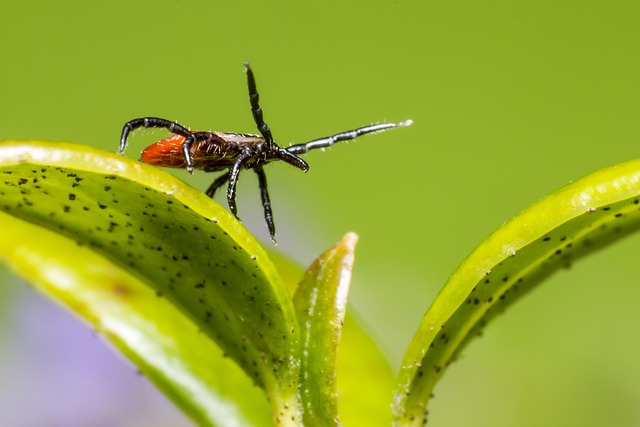In commercial spaces like offices and shopping malls, managing ticks is crucial due to their disease transmission potential. Effective commercial tick prevention involves regular inspections, targeted treatments, employee/visitor education, and professional services using eco-friendly chemicals and IPM strategies. Robust tick prevention strategies protect employees, prevent disruptions, and maintain productivity in outdoor work environments. Specialized services employ subtle techniques like natural repellents and strategic landscaping to deter ticks without harming ecosystems. Regular inspections, eliminating nesting sites, and swift responses are key to successful commercial tick prevention, creating safer environments.
In today’s bustling commercial landscape, tick control is a critical yet often overlooked aspect of workplace wellness. Ticks, beyond being vectors for diseases like Lyme, pose a subtle but significant disruption to businesses and employees alike. This article delves into the world of commercial tick prevention, exploring strategies that go beyond visible measures. We’ll uncover discreet methods to create an environment where ticks thrive less, ensuring productivity remains high without causing pest-related bottlenecks. Understanding these tactics is essential for businesses aiming to protect their most valuable assets—their workforce.
Understanding Tick Control in Commercial Spaces
In commercial spaces, such as office buildings, shopping malls, and outdoor recreation areas, managing ticks is a significant concern for property managers and health officials alike. Commercial tick prevention involves implementing strategies to minimize the presence of ticks, which can transmit diseases like Lyme disease and Rocky Mountain spotted fever. This includes regular inspections, targeted treatments in high-risk areas, and educating employees and visitors about tick safety practices.
Professional tick control services play a crucial role in commercial settings by offering discreet and effective solutions. These experts employ advanced techniques, including spot treatment with environmental safe chemicals, to eliminate existing ticks while preventing their return. By focusing on key habitats and utilizing integrated pest management (IPM) approaches, these services ensure minimal disruption to daily operations, maintaining a healthy and safe environment for everyone in the commercial space.
The Impact of Ticks on Businesses and Employees
Ticks are more than just a nuisance; they can significantly impact businesses and their employees. In environments where people frequently interact with nature, such as outdoor recreation areas or rural settings, ticks pose a considerable risk. Commercial tick prevention is essential to maintain a healthy workplace and minimize disruptions.
Businesses operating in affected regions must implement effective commercial tick control measures to protect both their staff and operations. Regular inspections, proper landscaping, and employee training can reduce the presence of ticks. Proactive tick management not only ensures the well-being of employees but also prevents costly interruptions caused by tick-borne diseases. This is crucial for maintaining productivity and morale among workers who may be concerned about their health and safety in the workplace.
Discreet Methods for Tick Prevention
In the realm of commercial tick prevention, discreet methods play a crucial role in minimizing disruption to businesses and their operations. Professional tick control services employ specialized techniques that target specific habitats while preserving the overall ecosystem. These strategies include selective applications of eco-friendly pesticides and natural repellents, ensuring minimal impact on non-target species and the environment.
Discreet tick prevention also involves regular monitoring and maintenance. Trained professionals inspect areas prone to tick activity, such as woodlands and lush greenery, implementing preventive measures like landscape modifications and strategic planting. By adopting these discreet methods, commercial spaces can effectively deter ticks without causing ecological imbalances.
Implementing Effective Commercial Tick Prevention Strategies
Implementing effective commercial tick prevention strategies is paramount for businesses operating in areas where ticks are prevalent, such as outdoor spaces and rural regions. Start by identifying high-risk zones within your premises. Ticks thrive in lush vegetation, tall grasses, and wood piles, so regular inspections can help locate and mitigate these hazards. Next, employ integrated pest management (IPM) techniques to disrupt the tick lifecycle. This includes eliminating potential nesting sites, regularly removing debris, and maintaining a clean, mowed lawn.
For added protection, consider using repellents and treatments specifically designed for commercial use. Permethrin-based products are highly effective in killing ticks when applied to clothing, footwear, and gear. Additionally, treat outdoor areas with tick-repelling landscaping plants or topical applications to create a natural barrier. Regular monitoring and rapid response to any tick presence will ensure the effectiveness of these strategies, providing employees and visitors with a safer environment while minimizing disruption to business operations.
Discreet tick control services are essential for maintaining a safe, productive, and comfortable commercial environment. By adopting effective commercial tick prevention strategies, businesses can mitigate the impact of these minuscule invaders on both employees and operations. Regular monitoring and discreet application of prevention methods ensure a minimal disruption to daily activities while safeguarding against potential health risks associated with tick bites. Investing in such services is a proactive step towards fostering a healthier, more productive workplace.
